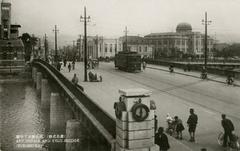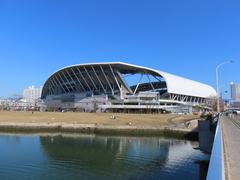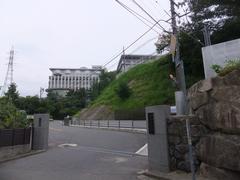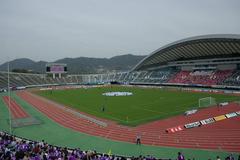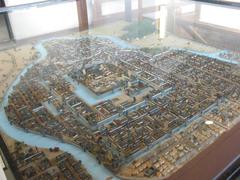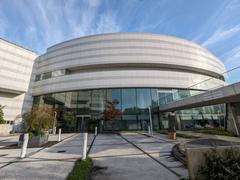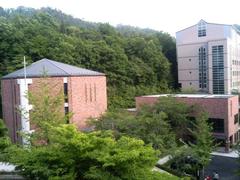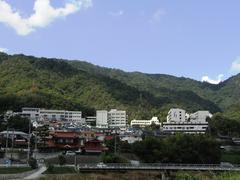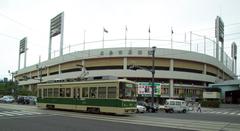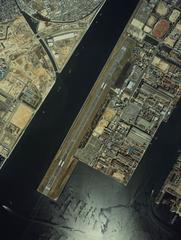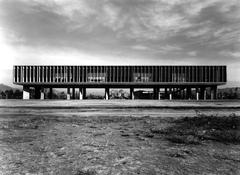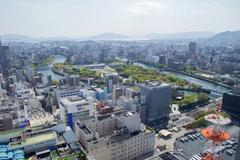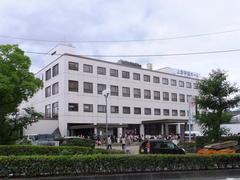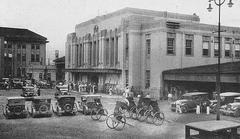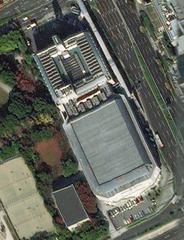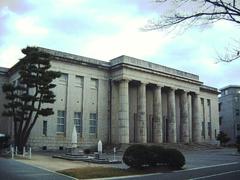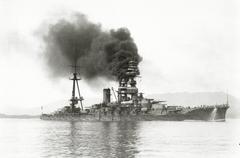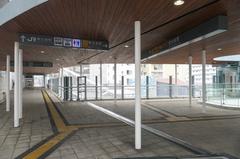Hiroden-Nishi-Hiroshima Station: Visiting Hours, Tickets, and Travel Guide
Date: 04/07/2025
Introduction
Hiroden-Nishi-Hiroshima Station (広電西広島駅), formerly known as Koi Station, is a cornerstone of Hiroshima’s public transportation network. Serving as a vital gateway between the city’s vibrant urban center and outlying districts—including the renowned Miyajima Island—the station is both a living witness to Hiroshima’s history and a modern, accessible transit hub. For travelers and history enthusiasts, Hiroden-Nishi-Hiroshima Station provides seamless tram, train, and bus connections, while offering insights into the city’s resilience, especially its rapid recovery following the devastation of World War II. This guide details the station’s history, visiting hours, ticketing options, layout, accessibility, and nearby attractions, ensuring an informed and enjoyable visit.
Historical Background and Significance
Early Development and Establishment
The roots of Hiroden-Nishi-Hiroshima Station reach back to the early 20th century, with the founding of the Hiroshima Electric Railway Company (Hiroden) in 1910. By 1912, the company launched its first streetcar lines, soon extending routes to Koi (now Nishi-Hiroshima), connecting the city center with growing suburbs. In 1931, the tram network reached Miyajima-guchi, facilitating direct access to Miyajima Island (Japan Experience, Urban Transport Magazine).
Wartime Resilience
During World War II, Koi Station played a critical role in moving workers and supporting wartime logistics. The atomic bombing of Hiroshima in 1945 devastated the tram system—destroying vehicles and infrastructure and resulting in significant loss of life among Hiroden employees. Remarkably, service resumed just three days after the bombing, with the first tram departing from Koi Station, symbolizing Hiroshima’s determination and resilience (Asahi Shimbun, Wikipedia: Hiroshima Electric Railway).
Postwar Reconstruction and Modernization
Following the war, Hiroden-Nishi-Hiroshima Station was pivotal in the city’s recovery. The tram system was rebuilt and expanded, and the station became an important interchange with the JR West Sanyo Main Line at the adjacent JR Nishi-Hiroshima Station. Today, Hiroden operates a diverse fleet, including historic and atomic-bomb-surviving trams, earning the nickname “The Moving Streetcar Museum” (Wikipedia: Nishi-Hiroshima Station).
Cultural and Community Role
Located in Koi-hon-machi, the station is integrated into local culture—most notably as the setting for “The Zukkoke Trio,” a celebrated children’s book series commemorated by a monument nearby (Dive Hiroshima). Vintage trams and the station’s unique architecture attract both locals and visitors, making it a vibrant, historical, and social landmark (Japan Experience).
Station Layout, Facilities, and Accessibility
Platform Configuration and Structure
Hiroden-Nishi-Hiroshima Station features side platforms for inbound and outbound trams, protected by canopies and equipped with bilingual signage. Tactile paving and ramps enhance accessibility for visually impaired and mobility-challenged passengers. Adjacent to the tram platforms, the JR Nishi-Hiroshima Station is easily accessible via covered walkways, allowing smooth transfers between tram and train services (Cestee, Rome2Rio).
Facilities and Amenities
- Waiting Areas: Sheltered benches and heated waiting rooms (in winter).
- Restrooms: Clean, wheelchair-accessible, and equipped with baby-changing facilities.
- Vending Machines: Drinks and snacks are available at various points.
- Coin Lockers: Secure storage for luggage and belongings.
- Bicycle Parking: Adjacent parking and access to the Peacecle bike-sharing system.
- Information Desk: Staffed during peak hours, offering English-language assistance.
- Universal Design: Ramps, elevators, tactile guides, and audio announcements for accessibility (Trip to Japan).
Signage and Navigation
Multilingual signage (Japanese, English, Chinese, Korean) and digital displays with real-time updates help passengers navigate the station with ease.
Visiting Hours and Ticketing Information
Operating Hours
- Station and Tram Services: Daily from approximately 5:30 AM to midnight; check official Hiroden schedules for route-specific first and last tram times.
- JR Nishi-Hiroshima Station: Parallel train services operate from early morning to midnight.
Ticketing and Fare Payment
- Tram Fares: Flat rate (approx. ¥190) within city limits; fares increase for trips to Miyajimaguchi (approx. ¥280).
- Ticket Purchase: Available at vending machines, on board, or at station counters.
- IC Cards: PASPY, ICOCA, Suica, and other major IC cards are accepted.
- Day Passes: Unlimited rides on Hiroden lines, ideal for tourists and those making multiple stops.
- JR Tickets: Purchase at automated machines or staffed counters; IC cards also valid.
Accessibility
All station facilities and vehicles are designed for universal accessibility, including ramps, elevators, and designated priority seating. Assistance is available upon request.
Transportation Connections
Hiroden Tram Lines
- Line 2: Hiroshima Station – Hiroden-Miyajima-guchi (direct access to Miyajima Island ferry).
- Line 3: Hiroden-Nishi-Hiroshima – Hiroshima Port, serving central and southern districts.
JR West Sanyo Main Line
- Key Destinations: Hiroshima Station (Shinkansen hub), Miyajimaguchi (for Miyajima Island), Iwakuni, and beyond.
Bus, Taxi, and Bicycle Options
- Bus: Hiroden (Green Bus) and Hiroshima Bus (Red Bus) lines reach neighborhoods outside tram and train coverage (City of Hiroshima).
- Taxi: Stands available at station exits; taxis are metered and reliable.
- Bicycle: Peacecle bike-sharing stations nearby; ample parking for personal bicycles.
Sightseeing Buses
- Meipuru-pu: Hop-on/hop-off bus covering major Hiroshima attractions with unlimited ride day passes (Trip to Japan).
Nearby Attractions
- Hiroshima Peace Memorial Park & Atomic Bomb Dome: Accessible in 10–15 minutes by tram; a UNESCO World Heritage site and symbol of peace (Hiroshima Peace Memorial Museum).
- Miyajima Island: Reachable via tram to Miyajimaguchi, then ferry; home to Itsukushima Shrine’s floating torii (Visit Miyajima Japan).
- Hiroshima Castle: Historical castle reconstructed after WWII, featuring a museum and panoramic vistas (Hiroshima Castle).
- Shukkei-en Garden: Classic Japanese garden known for seasonal beauty (Shukkei-en Garden).
- Hondori Shopping Street: Lively arcade for shopping, dining, and Hiroshima-style okonomiyaki (Hondori Shopping Street).
- The Zukkoke Trio Monument: Celebrates a beloved literary trio, offering a local cultural touch (Dive Hiroshima).
- Orizuru Tower: Panoramic observation deck and peace-themed experiences (Orizuru Tower).
- Mazda Museum: Guided tours of Mazda’s heritage and technology (advance reservation required; Mazda Museum).
Day Trips and Scenic Excursions
- Miyajima Island: For Itsukushima Shrine and hiking trails.
- Takehara (“Little Kyoto”): Edo-era streets and bamboo groves.
- Mount Kurotaki & Mount Haigamine: Renowned for hiking and scenic night views.
- Onomichi & Senkoji Temple: Famous cycling routes and hilltop temple with port views (Japan Experience).
Practical Tips for Visitors
- Travel Passes: Consider day passes for unlimited travel; IC cards simplify fare payment.
- Luggage Storage: Use coin lockers for convenience.
- Language: Carry destinations in Japanese or use a translation app; signage is generally bilingual.
- Rush Hours: Travel outside 7:30–9:00 AM and 5:00–7:00 PM for a relaxed experience.
- Weather: Covered walkways are useful during Hiroshima’s rainy season (June–July).
- Food: Local eateries, bakeries, and izakayas are within walking distance; try Hiroshima-style okonomiyaki and Seto Inland Sea oysters.
Safety and Local Etiquette
- Orderliness: Queue for trams and trains; keep noise to a minimum.
- No Eating/Drinking: Refrain from eating or drinking on public transport.
- Escalator Etiquette: Stand on the right, walk on the left.
Unique Features and Cultural Insights
- Hibaku Densha: Ride the atomic bomb survivor trams for a living link to Hiroshima’s past.
- Community Hub: The station is frequented by locals, students, and commuters—offering an authentic slice of daily life.
Frequently Asked Questions (FAQ)
Q: What are Hiroden-Nishi-Hiroshima Station’s visiting hours?
A: Approximately 5:30 AM to midnight, with tram and JR train services running throughout these hours. (Hiroden official site)
Q: How do I buy tickets?
A: Purchase at vending machines, from tram conductors, or at staffed counters. IC cards (PASPY, ICOCA, Suica, etc.) are widely accepted.
Q: Is the station accessible for travelers with disabilities?
A: Yes. Elevators, ramps, tactile paving, and priority seating are provided.
Q: Are there luggage storage facilities?
A: Yes, coin lockers are available.
Q: How do I transfer between Hiroden trams and JR trains?
A: Covered walkways and clear bilingual signage make transfers quick and easy.
Q: What are the best nearby attractions?
A: Peace Memorial Park, Miyajima Island, Hiroshima Castle, Shukkei-en Garden, and Hondori Shopping Street.
Conclusion
Hiroden-Nishi-Hiroshima Station is much more than a transit node; it is a gateway to Hiroshima’s historical, cultural, and scenic riches. With its accessible design, multilingual support, and direct links to major sites, the station embodies Hiroshima’s enduring spirit and commitment to welcoming visitors from around the world. Plan your trip using the official Hiroden website and JR West for the latest updates, and make the most of your journey by exploring the nearby attractions, engaging in local traditions, and taking part in Hiroshima’s vibrant community life.
For effortless navigation, download the Audiala app for real-time transit updates, guided tours, and personalized travel tips. Discover more about Hiroshima’s historical sites and travel experiences on our website, and follow us on social media for the latest inspiration.
Sources
- Japan Experience
- Urban Transport Magazine
- Wikipedia: Hiroshima Electric Railway
- Wikipedia: Nishi-Hiroshima Station
- Asahi Shimbun
- Dive Hiroshima
- Cestee
- Rome2Rio
- Trip to Japan
- City of Hiroshima
- Hiroshima Peace Memorial Museum
- Hiroshima Castle
- Shukkei-en Garden
- Hondori Shopping Street
- Orizuru Tower
- Mazda Museum
- Visit Miyajima Japan
